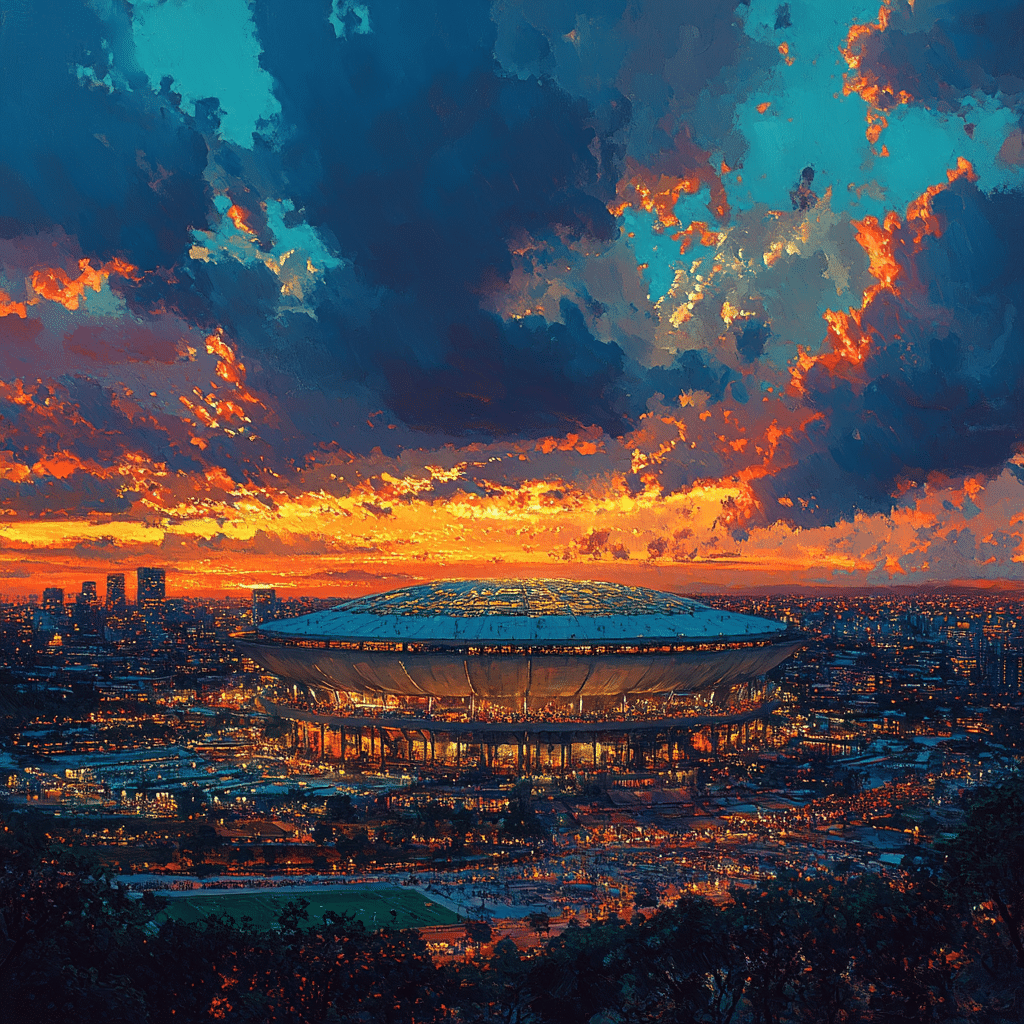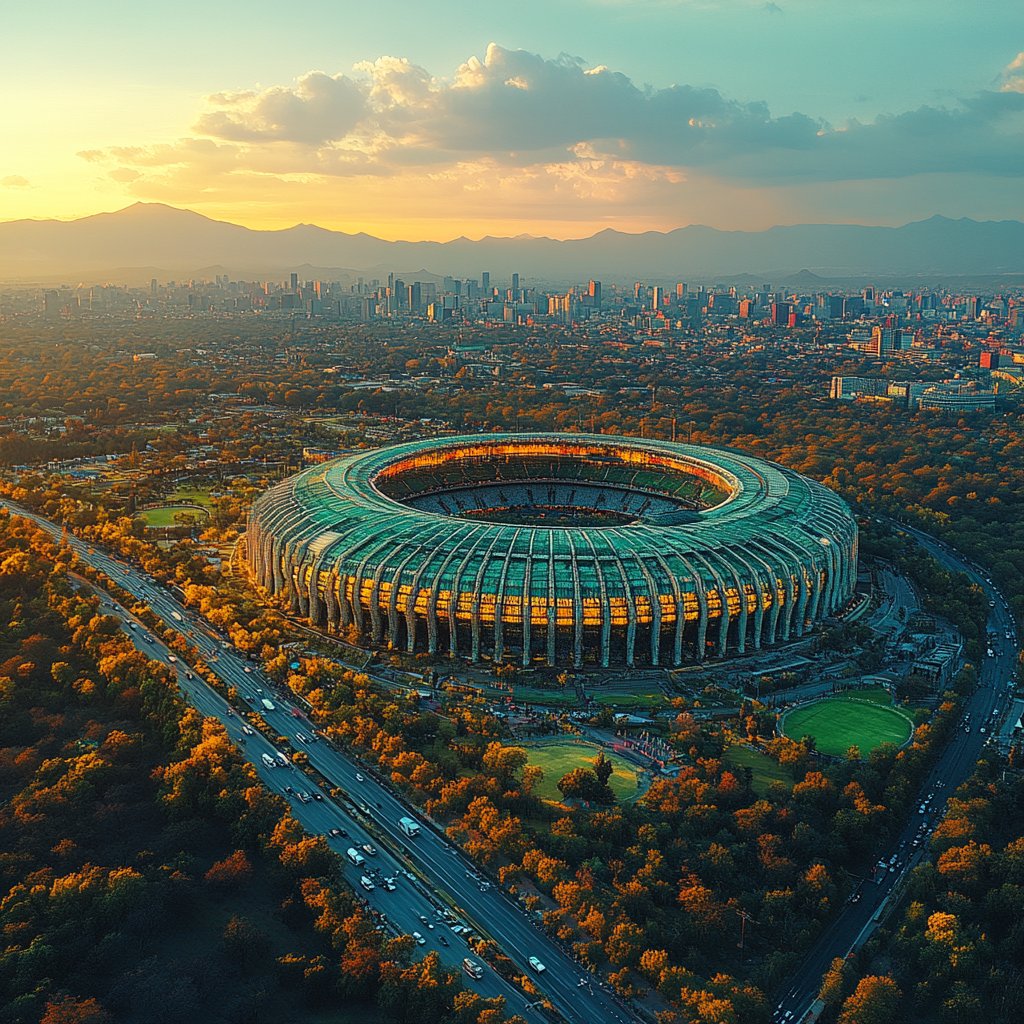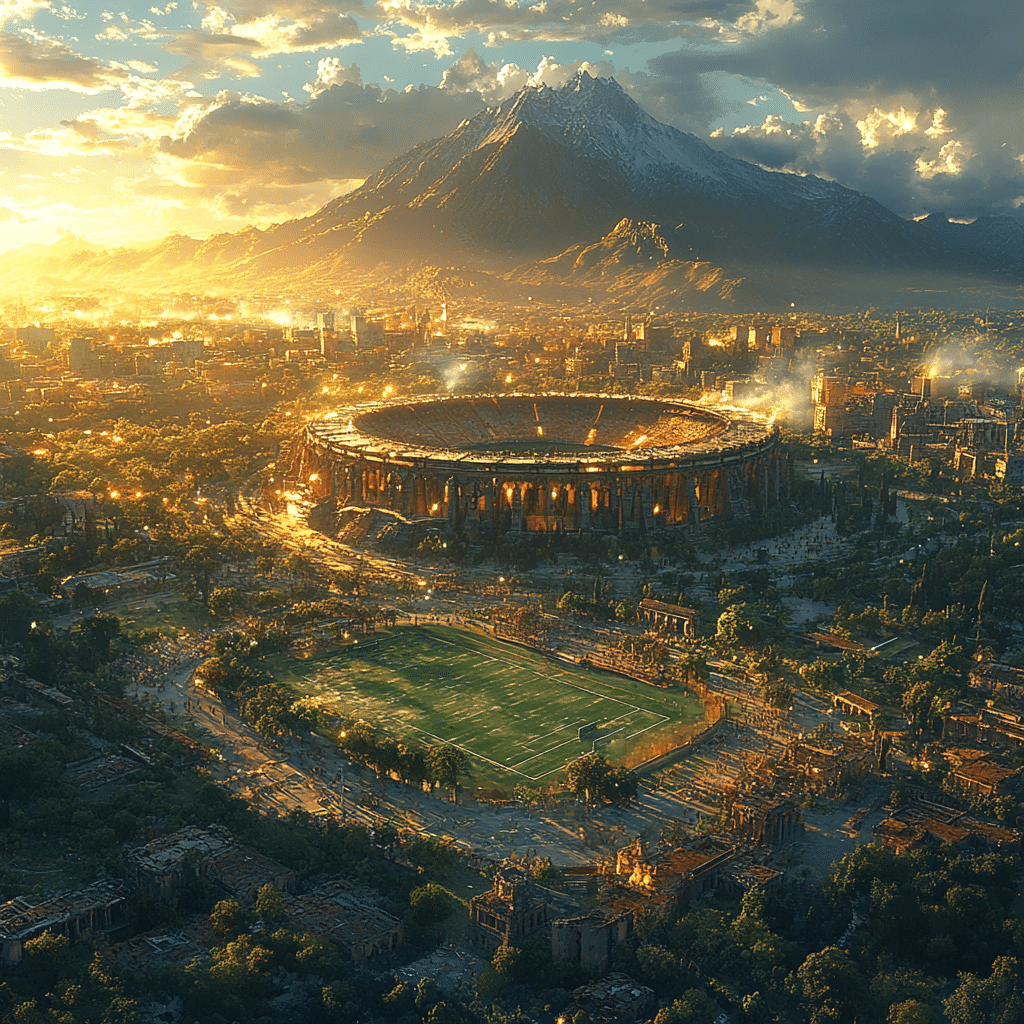The Historical Significance of Estadio Azteca
The Estadio Azteca, located in the vibrant Mexico City, is not just a stadium; it’s a legend. Opened on May 29, 1966, this colossal venue greeted its first spectators with a friendly football match between Club América and Italy’s Torino. Fast forward to today, and Estadio Azteca has rightfully earned its place as one of the world’s most revered sports arenas, holding the record as the first to host two FIFA World Cup finals – an honor that signifies its rich history in global football.
As the third largest football stadium in the Americas and the 11th largest in the world, with an astounding capacity of 87,523 spectators, the Estadio Azteca isn’t just a site for football; it’s a cultural epicenter. Its hallowed grounds have resonated with the cheers of fans, capturing pivotal moments that continue to be talked about. Through the lens of legendary matches, we can see how the stadium not only shaped the history of football but also influenced Mexican culture and identity.
From its storied events to the passionate displays of national pride, Estadio Azteca serves as a bridge connecting generations of football enthusiasts. Whether you’re a die-hard fan or a casual observer, the history embedded in the very walls of this iconic stadium invites everyone to feel part of its legacy. The significance of the Estadio Azteca extends far beyond the pitch, making it a must-visit for anyone seeking a genuine taste of football’s history.

Top 5 World Cup Moments at Estadio Azteca
1. The 1970 Final: Brazil vs. Italy
The 1970 World Cup Final will forever be etched in the annals of football history, held within the majestic confines of Estadio Azteca. Brazil dazzled on that day, triumphing over Italy with a score of 4-1. This match showcased the brilliance of legends like Pelé, whose dazzling moves and extraordinary skills left fans breathless. Just imagine standing among over 100,000 fans, all mesmerized by a performance that celebrated the sport’s beauty.
2. Diego Maradona’s ‘Hand of God’ Goal (1986)
In the 1986 World Cup quarter-finals, Diego Maradona gave birth to a moment that would echo through time. The infamous ‘Hand of God’ goal carved out his legacy while also fueling debates about sportsmanship. The sheer drama of the match against England left fans on the edge of their seats, climaxing in what many consider the ‘Goal of the Century.’ Estadio Azteca witnessed not just a game but an emotional rollercoaster that would redefine football narratives forever.
3. Mexico’s Victory Against Poland (1978)
During the 1978 World Cup, an emotional chapter unfolded as Mexico clashed with Poland in Estadio Azteca. Although Mexico didn’t progress far in the tournament, this match ignited the fervor of national pride. The stadium roared with passion, enveloping fans in a wave of cheer and hope, emphasizing a profound connection between football and Mexican identity. It was more than just a game; it was a celebration of culture under the historic Azteca roof.
4. The 1986 Semi-Final: West Germany vs. France
If you love nail-biting football, the semi-final between West Germany and France in 1986 will send shivers down your spine. Ending 2-2 after extra time, the match headed to penalties, captivating the audience at Estadio Azteca. The tension was palpable as West Germany emerged victorious, reaffirming the stadium’s reputation as a battleground for giants. This epic showdown wasn’t just a sporting event; it was a slice of history unfolding live.
5. Mexico’s Emotional Exit (1994)
Even though the 1994 World Cup was held in the U.S., Estadio Azteca’s spirit lingered on. Mexico’s heart-wrenching exit at the hands of Bulgaria in a penalty shootout resonated deeply with its passionate fans. The emotions strained the hearts of those who had previously filled Estadio Azteca to witness their beloved team rise in glory. This match underlined the stadium’s longstanding significance to Mexican culture, forging a bond that goes beyond mere football.
Estadio Azteca: Cultural Impact Beyond the Games
The importance of Estadio Azteca extends well beyond football, as it has evolved into a cultural landmark. Offering far more than just matches, its venue has hosted legendary musical acts, with iconic bands like U2 and The Rolling Stones captivating audiences with unforgettable performances. These events transform the stadium into a dance of cultural celebration, allowing fans to connect with more than just athletic prowess.
The stadium thrives as a hub for music and significant community gatherings. The sight of thousands of fans enjoying a concert brings a sense of unity, illustrating how the Estadio Azteca transcends sporting events. This cultural significance is essential to understanding the complete essence of the venue, reinforcing its status as a national treasure in Mexican society.
Moreover, Estadio Azteca reflects the city’s spirit, echoing the vibrancy and passion of its local culture. Whether it’s a thrilling football match or an electrifying concert, people flock to this monumental place, creating memories that bond communities and generations. The vibrancy of Estadio Azteca encapsulates the very heart of Mexico, inviting visitors previously unaware of its cultural significance to explore its depths.

The Architectural Marvel of Estadio Azteca
Designed by celebrated architect Pedro Ramírez Vázquez, Estadio Azteca stands as an architectural feat, blending functionality with beauty. The stadium’s impressive structure accommodates the needs of modern sports while preserving its historical charm, allowing it to maintain relevance over the years. From its stunning design to its robust features, the stadium is truly a wonder to behold.
Moreover, the iconic architecture mirrors its distinctive characteristics; it sets itself apart as a beacon in the landscape of sports venues. The stadium is constructed to withstand the tests of time, with renovations and updates on the horizon to refresh its facilities for the upcoming 2026 World Cup. As we anticipate these changes, it’s clear that Estadio Azteca is committed to preserving its historical essence while adapting to modernity.
The enchanting atmosphere within the Estadio Azteca cannot be overstated. Inside, the excitement is electric, as fans cheer, sing, and revel in the moment, bringing life to its majestic design. This harmonious fusion of history and modernity makes Estadio Azteca a must-visit destination, offering everyone a chance to experience its life-enhancing energy firsthand.
The Future of Estadio Azteca
Looking forward, the future of Estadio Azteca shines bright. As plans for renovations unfold, fans can expect an enhanced experience when attending events. The stadium is gearing up for the highly anticipated 2026 World Cup, where it will once again serve as a premier venue. City planners and the Mexican Football Federation are joining forces to ensure the stadium continues to captivate audiences while meeting modern standards of safety and comfort.
In welcoming the future, Estadio Azteca is set to close its doors temporarily for renovations. This essential process will ensure that it remains a cornerstone of world football, blending its historic charm with state-of-the-art facilities. As we steer toward a new era, one thing is certain: Estadio Azteca will continue to be a focal point for football enthusiasts and locals alike.
With a commitment to preserving its lively spirit and historical significance, the stadium promises an unforgettable future. Fans can eagerly anticipate the moment when they’ll once again gather under its towering façade, united in passion for the beautiful game. Excitement brews as the next chapter in Estadio Azteca history approaches, reaffirming its position as an unyielding symbol of football excellence.
The Everlasting Legacy of Estadio Azteca
The legacy of Estadio Azteca is profound, symbolizing more than just a venue for sports; it represents the heartbeat of communities, national pride, and unforgettable memories. The echo of football cheers fills its spaces, resonating with the passion and emotions of fans. This remarkable stadium continues to forge connections that will last a lifetime, nourishing the souls of millions around the world.
Estadio Azteca serves as a reminder of football’s power to unite communities, not just in national pride but in shared experiences. From thrilling matches to soul-stirring concerts, the stadium weaves a rich tapestry of moments that remain etched in the memories of those fortunate enough to witness them. Its enduring charm captivates hearts and ignites passion across generations, from intimate gatherings to monumental events.
As it prepares for its future, Estadio Azteca stands as a testament to perseverance and passion. The echoes of past triumphs and the anticipation of future accolades will continue to define its space. With every game and every cheer, the stadium’s legendary past and promising future ensure it remains a cherished element of football history, inspiring new generations to embrace the game and the culture that surrounds it.
In short, if you’re planning a trip, make sure Estadio Azteca is on your must-visit list. Its history, grandeur, and cultural significance combine to create an experience that transcends the ordinary. Whether you’re a passionate football supporter or a curious traveler, Estadio Azteca welcomes you with open arms, ready to share its story with anyone willing to listen.
Estadio Azteca: The Legendary Home of World Cup Triumphs
Fun Facts About Estadio Azteca
Did you know that Estadio Azteca is the first stadium in history to host two FIFA World Cups? That’s right! This iconic venue in Mexico City held the World Cup in 1970 and then again in 1986, making it a hotspot for global soccer fans. It’s not just the matches that make it special; the stadium also has remarkable seating for 87,523 spectators, creating an electrifying atmosphere during events. Much like the architectural marvels seen in the Sunset Boulevard movie, Estadio Azteca stands as a testament to design that marries function with excitement.
Another interesting nugget you might find delightful is that Estadio Azteca has been the backdrop for some legendary matches, including Diego Maradona’s famous “Hand of God” goal. This iconic moment transformed the stadium into a hallowed ground for soccer aficionados around the globe. Speaking of legends, the venue has hosted a variety of events, from concerts to sporting spectacles, following its ethos of providing unforgettable experiences like those promoted by Conference keynote Speakers.
The Legacy Continues
In addition to its soccer history, Estadio Azteca has hosted famed artists like The Rolling Stones and U2, attracting music lovers from all walks of life. It serves as a cultural hub, akin to the relaxing vibes found at Orvis Hot springs, drawing locals and tourists alike. Furthermore, its capacity for such massive audiences has made it a landmark for various types of events, ensuring its legacy as a go-to destination for entertainment.
But don’t think it’s just about the past! Estadio Azteca is gearing up for future tournaments and events, promising to keep the spirit alive for generations to come. It’s a venue that has stories—much like the career highlights of actors such as Eddie Redmayne in movies—etched into its walls, always inviting fans to write new chapters. Whether you’re catching a soccer match or a concert, this stadium is a celebration of fitness, music, and most importantly, community spirit. So, next time you hear about Estadio Azteca, remember: it’s not just a stadium; it’s where legends are made!

Is Estadio Azteca the biggest stadium in the world?
No, Estadio Azteca isn’t the biggest stadium in the world; it’s the third biggest in the Americas and the 11th biggest globally, with a capacity of 87,523 spectators.
Why is the Estadio Azteca important?
Estadio Azteca is important because it’s one of the most iconic stadiums worldwide and uniquely hosted two FIFA World Cup finals, showcasing epic matches and legendary players over the years.
What is the largest arena in Mexico?
The largest arena in Mexico is Estadio Azteca, well-known for its rich history and massive events.
Is the Estadio Azteca closed?
Yes, Estadio Azteca is currently closed for renovations in preparation for the 2026 World Cup, which will be its third time hosting this major event.
What is the top 10 biggest stadium in the world?
The top 10 biggest stadiums in the world include places like Rungrado 1st of May Stadium in North Korea, and Camp Nou in Spain, among others, with Estadio Azteca coming in at number 11.
Who is hosting the World Cup in 2026?
The 2026 World Cup will be hosted by the United States, Canada, and Mexico, with Estadio Azteca set to play a key role in the festivities.
What is the biggest stadium in the US?
The biggest stadium in the US is Michigan Stadium, located in Ann Arbor, with a capacity of over 107,000 fans.
What does Azteca stand for?
“Azteca” doesn’t have a specific stand-alone meaning but generally refers to the Aztec civilization, which is a significant part of Mexican history.
Is Estadio Azteca grass or turf?
Estadio Azteca has natural grass, which is preferred for major football matches to ensure the best playing conditions.
What is the biggest amusement park in Mexico?
The biggest amusement park in Mexico is Parque Xcaret, a popular eco-archaeological park offering shows, attractions, and cultural experiences.
What country has the biggest arena in the world?
North Korea has the largest arena in the world, which is the Rungrado 1st of May Stadium, holding around 114,000 spectators.
How many people fit in the Estadio Azteca for a concert?
Estadio Azteca can fit around 87,000 people for a concert, making it a great venue for big performances.
Which club owns the Estadio Azteca?
Club América is the permanent host of Estadio Azteca and has called it home since the stadium opened.
How much is a suite in Estadio Azteca?
Suites at Estadio Azteca can vary widely in price but typically start at several thousand dollars, depending on the event and amenities.
How far is the airport from Estadio Azteca?
The airport, specifically Aeropuerto Internacional Benito Juárez, is about 10-15 kilometers from Estadio Azteca, depending on traffic and route taken.
























